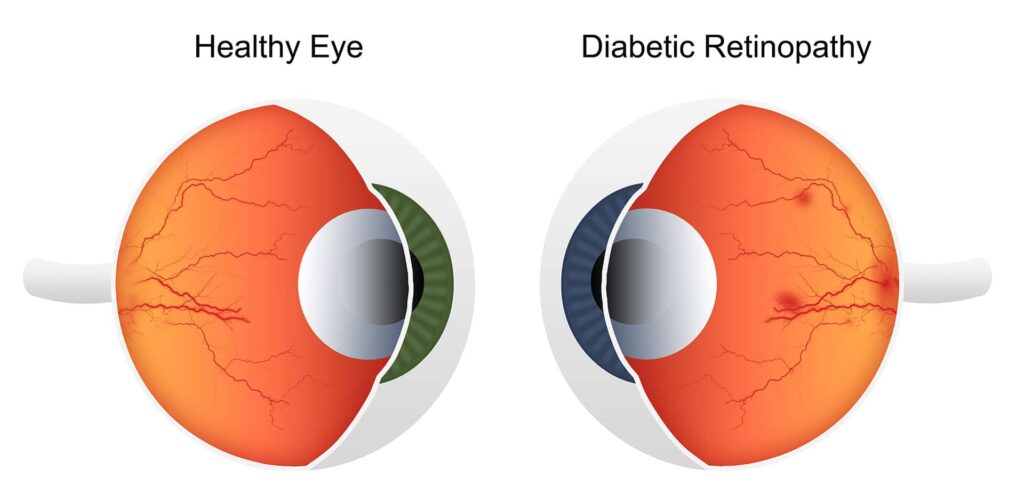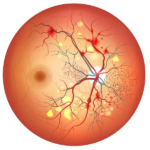Diabetes mellitus is most non-communicable disease which affects almost all the intermediator organs of the body. Diabetes is commonly known as metabolic and vascular syndrome which affects blood vessels, heart, kidney, nerves and eye in due course of time. Complications of diabetes are concomitant in nature, that means complications go hand in hand with the disease for the entire life. In the eye the retinal blood vessels are mostly affected and leads to diabetic retinopathy. Though in the initial stage the blood vessels of the retina are affected, later on when the disease progressed the macula, retinal pigment cells and nerve fibers which carry nerve the visual impulse to the brain are also affected.

Symptoms of Diabetic Retinopathy
Symptoms like micropsia (small image), diminutions of vision (decrease of vision), macropsia (large image), photopsia (image with lightening type), difficulty in dark adaptation, difficulty in driving vehicle and floaters are common in different stages of diabetic retinopathy (DR).

Pathogenesis
In Ayurveda, diabetic retinopathy and its symptoms can be managed well in early stages and the disease progression can be arrested with proper procedures and medications. In diabetes mellitus which can be correlated with Vataja Prameha, where vata dosha gets vitiated initially but tridosha (Vata, Pitta, Kapha) prakopa is the main etiology which leads to Abhisyanda (clogging of minute blood vessels) in the eye. And in the end the minute blood vessels in the retina rupture and leads to hemorrhage and appearance of Raktapitta symptoms in turn causes the vision disturbances. Other important factors which causes the genesis of the disease are Agnimandya (low digestive power), Amadosha (oxidative damage of blood vessels) and Raktapitta (bleeding from the blood vesels).
Treatment and Management of Diabetic Retinopathy
As diabetic retinopathy is concomitant in nature, the management involves treatment of main disease i.e. diabetes as well as diabetic retinopathy simultaneously. Hence a holistic approach of Panchakarma, Kriyakalpa and Yoga are essential with diet therapy. The treatment of diabetic retinopathy involves first evaluation of the stages of diabetic retinopathy, assessment of prakriti (epigenetic character of the person), predominant Dosha involved and visual symptoms. On the basis of diagnosis, first Sodhan (purificatory) therapies are given. Videhan, Nasya etc are given first as Sodhan therapy and then Shaman (oral drug administration) therapies and Kriyakalpa (ocular therapeutics) procedures are given to alleviate the symptoms. Kriyakalpa procedures like Netra Tarpan, Ashyotan, Pindi, Vidalaka and Anjan are given. Panchakarma procedures like Basti, Nasya, Shirodhara, Shiroplepa, Talam, Takradhara are advised on the basis of their diagnosis of stages of DR or severity of the symptoms. Medicaments used for this procedure are selected on the basis of Dosha involved and stage of the DR pathology.
In case of Vata predominant tridosha parakopa diabetic retinopathy patients medicines like Basantakusumakar Rasa, Bruhat vatachintamani Rasa, Saptamruta lauha, Yastimadhu churna are given for therapeutic use. In case of Pitta predominant tridosha cases and moderate to severe NPDR cases Virechan, Vasakadi Kashaya, Vasaguluchyadi Kashaya, Chandanadi Anjan, Mahatiktaka Ghrita, Ksheerbala 101 Nasya, Yasad bhasma, Guggulutiktaka Ghrita, Amalaki Rasayan, Praval pisti etc are given as individual single drugs are combination of multiple drugs based on the stage and severity of the disease. In Kapha predominant tridosha cases medicines like Amrutadi guggulu, patoladya Ghrita, Triphala Ghrita, Mahatiktaka Ghrita, pathyasadanga Kashaya etc. can be given under supervision of an Ayurvedic ophthalmologist. In aggravated conditions of both Rakta and Pitta cases Virechan, Nasya with Bhringaraj taila, Ksheerabal taila, Anutaila, Guduchyaditaila etc are given. Shrirodhra, Takradhara are highly recommended. Medicines like Vasavaleha, Vasaguduchyadi Kashaya, Chandanadi Anjan etc are given to protect the retina for further bleeding. Triphala churna and Curcumin tablet are recommended regularly as both of the drugs have Anti VEGF activity to protect the retina.
Written by: Dr. Prasanta Kumar Sahoo
Related quick view:
For Ayurvedic Treatment for Diabetic Retinopathy, you can Contact our Astang Ayurveda hospital at Bhubaneswar, India.
For inquiry, Call us;
or Mail us;
Get Directions to Our Location on the Map
